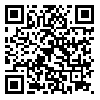Sun, Apr 27, 2025
[Archive]
Volume 38, Issue 1 (1-2024)
Med J Islam Repub Iran 2024 |
Back to browse issues page
Download citation:
BibTeX | RIS | EndNote | Medlars | ProCite | Reference Manager | RefWorks
Send citation to:



BibTeX | RIS | EndNote | Medlars | ProCite | Reference Manager | RefWorks
Send citation to:
Bagheri M H, Kabiri M, mohamadian roshan N, Shams Hojjati S Y, Rezaei E. Comparison of Viability of the Preserved Autologous Aspirated Fat Tissue Transfer in Refrigerated and Frozen Specimens. Med J Islam Repub Iran 2024; 38 (1) :168-171
URL: http://mjiri.iums.ac.ir/article-1-8698-en.html
URL: http://mjiri.iums.ac.ir/article-1-8698-en.html
Mohammad Hasan Bagheri 

 , Mona Kabiri
, Mona Kabiri 

 , Nema Mohamadian roshan
, Nema Mohamadian roshan 

 , Seyed Yavar Shams Hojjati
, Seyed Yavar Shams Hojjati 

 , Ezzatollah Rezaei
, Ezzatollah Rezaei 




 , Mona Kabiri
, Mona Kabiri 

 , Nema Mohamadian roshan
, Nema Mohamadian roshan 

 , Seyed Yavar Shams Hojjati
, Seyed Yavar Shams Hojjati 

 , Ezzatollah Rezaei
, Ezzatollah Rezaei 


Endoscopic and Minimally Invasive Surgery Research Center, Mashhad University of Medical Sciences, Mashhad, Iran , RezaeiE@mums.ac.ir
Abstract: (1023 Views)
Background: Fat graft surgery is one of the most effective procedures in plastic surgery, and since some patients request multiple surgeries and these cases sometimes take hours, it endangers the viability of the fat graft. In this study, we intend to evaluate the viability of adipose tissue aspirated with a syringe at refrigerator (4°C) and freezer (–20 °C) temperatures.
Methods: This was a cross-sectional study. After receiving the ethics committee's approval (IR.MUMS.MEDICAL.REC.1401.423), 17 volunteers entered the study. The harvested fat tissue sample was divided into 3 parts, and each of them was transferred to 3 separate sterile tubes. The first tube was sent to the laboratory for preliminary examination of fresh fat, and the second tube was transferred to a 4°C refrigerator for 72 hours. The sample from the third tube was first passed through a strainer and after drying, it was transferred to a –20°C freezer for 72 hours. After treatment with trypsin, we placed the sample inside the centrifuge using the Coleman method. Finally, 3 layers were formed, and the white middle layer was extracted as a fat cell suspension. Tissue samples were stained with trypan blue, and the percentage of viable cells was calculated using an optical microscope.
Results: There was a significant difference between the mean number and percentage of viable cells in all 3 groups. Samples in the 4°C refrigerator had significantly more cellular viability than those in the –20°C freezer (mean difference, 72.842%; P < 0.001).
Conclusion: Our findings showed that after 72 hours at 4°C, adipose tissue has significantly higher survival than at –20°C (98.93% vs 75.31%). Since the survival of fat cells is one of the direct determinants of fat retention, it can affect the results after surgery. The present study recommends fresh adipose tissue for immediate transplantation unless there is an urgent need for cold storage.
Methods: This was a cross-sectional study. After receiving the ethics committee's approval (IR.MUMS.MEDICAL.REC.1401.423), 17 volunteers entered the study. The harvested fat tissue sample was divided into 3 parts, and each of them was transferred to 3 separate sterile tubes. The first tube was sent to the laboratory for preliminary examination of fresh fat, and the second tube was transferred to a 4°C refrigerator for 72 hours. The sample from the third tube was first passed through a strainer and after drying, it was transferred to a –20°C freezer for 72 hours. After treatment with trypsin, we placed the sample inside the centrifuge using the Coleman method. Finally, 3 layers were formed, and the white middle layer was extracted as a fat cell suspension. Tissue samples were stained with trypan blue, and the percentage of viable cells was calculated using an optical microscope.
Results: There was a significant difference between the mean number and percentage of viable cells in all 3 groups. Samples in the 4°C refrigerator had significantly more cellular viability than those in the –20°C freezer (mean difference, 72.842%; P < 0.001).
Conclusion: Our findings showed that after 72 hours at 4°C, adipose tissue has significantly higher survival than at –20°C (98.93% vs 75.31%). Since the survival of fat cells is one of the direct determinants of fat retention, it can affect the results after surgery. The present study recommends fresh adipose tissue for immediate transplantation unless there is an urgent need for cold storage.
Type of Study: Original Research |
Subject:
Plastic Surgery
Send email to the article author
| Rights and permissions | |
 |
This work is licensed under a Creative Commons Attribution-NonCommercial 4.0 International License. |





